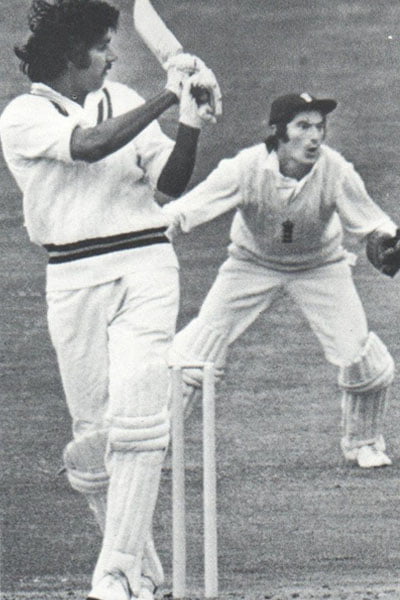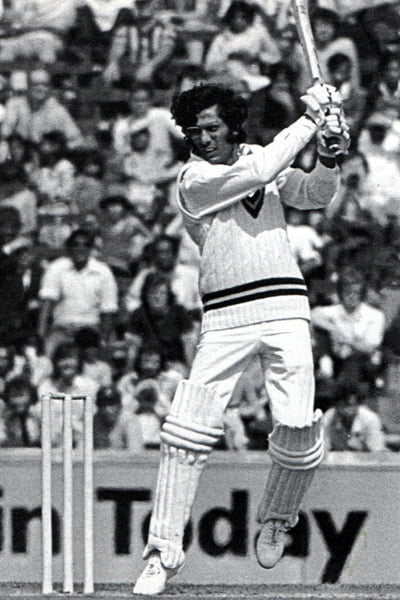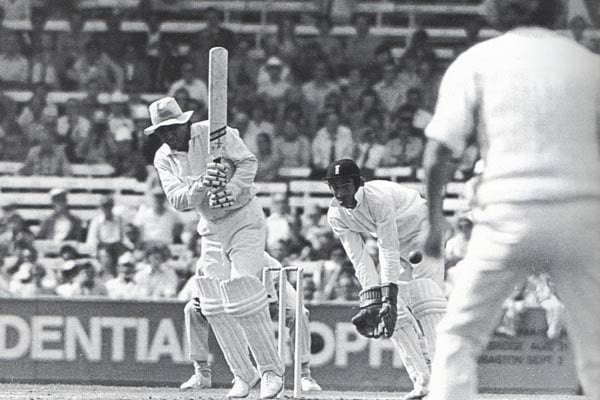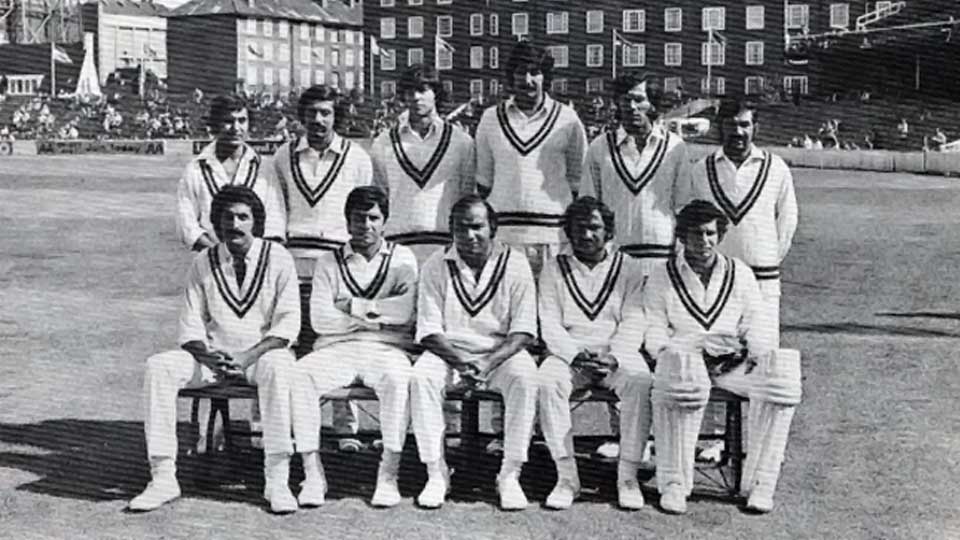Certain tour and on occasions a match define some real transformation in a team’s fortunes – heralding a new era. Very rarely events of a single day have a comparable impact.
In 1974, Pakistan shared the English summer with India with both playing three tests against the hosts. India were there for the first half of the season. On their last visit to England, in 1971, the Indians had created history.
They not only won their first ever Test match on the English soil but also the series 1-0. The 1974 Indian team didn’t show many changes from the winning outfit of three years back.

In between, India had also been 2-1 winners over touring England team (then called MCC) in their own backyard.
Their legendary spinning quartet of Bedi, Chandrashkhar, Prasanna and Venkatarghavan, instrumental in those two series victories, was seemingly still at its peak. They were again led by Wadekar. Batting lineup retained two of India’s all-time greats in Gavaskar and Viswanath as well as that brilliant wicket keeper batsman Farokh Engineer.
Even the two opening bowlers, Abid Ali and Solkar were also there. Those days, India’s almost total dependency on the spinners meant they had little role. Abid and Solkar were useful batsmen too and the latter is remembered more for his fielding at forward short leg than either of the other two skills.
Hence, a keen contest was anticipated in the Test series. The Indians started the tour on what one may call a bit cautious note. They drew all the first nine three day first class fixtures. However, they picked up and won five of the next six matches before the first Test; peaking at the right time.
But the Indians failed miserably in all the three tests. The audacity of England can be gauged from the fact that in the very first test, they gave India a target of only 296 on the last day, declaring their second innings closed with only three wickets down. The visitors were bundled out for just 182 on the last day.

Worse was to follow. In the last two Tests, India not only suffered huge innings defeats but some undesirable feats also came their way. Their 42 in the second Test remains India’s lowest till today. England won the third Test losing just two wickets. The hosts also won both the ODIs with ease.
Pakistan had never won a Test series against England, home or away, and had just won a lone Test way back on the 1954 tour. They had won just one Test, against the then minnows, New Zealand, outside Pakistan over last decade and a half.
It was in this back drop that Pakistan had started their 1974 tour of the mother country. Prior to the first Test, they had only eight first class games as compared to 15 that India got. They too did well in the county games, winning six with other two drawn.
Now, the real test arrived with the first Test at Leeds. There were all kinds of speculations. Will they suffer the same fate as the Indians? But they have done very well in the county matches; Indians hadn’t done bad. As many as eight members of the team have been playing for the English counties; should be an advantage.
Pakistan won the toss and batted. When the first day ended, it was 227-9. Old, Arnold and Hendrick, who had decimated the Indians, were at it again. It seemed the chapter 2 of English summer 1974 wasn’t going to be much different from the first.
It was the second day of the first Test that must be recalled as one of the most defining in the history of Pakistan cricket. Sarfraz Nawaz (5*) and Asif Masood (1*), the no. 10 and no. 11, resumed the innings.
The English bowlers, who obtained a lot of movement pitching the ball up on the first day, continued with the same approach. But the 6’4 inch Sarfraz with his long stride repeatedly cover drove with great results.
It was an interesting partnership. While Sarfraz moved the score board, Asif Masood defended as if his life depended on it. Proper planning was involved. Sarfraz tried to face most of the bowling. Off the first three balls of an over, he went for his drives. Fourth ball onwards, he looked for a single so as to take the next over himself. It all proved to be quite frustrating for the English pacemen. It didn’t’ take long for the partnership to cross 50.
Soon, Sarfraz had his own first test half century. The pair created a new Pakistan record for the 10th wicket against England. When finally Sarfraz was bowled by Arnold, the stand had yielded 62 runs. Sarfraz’s share was 53 with eight fours off 74 balls. Asif Masood’s doggedness carried him undefeated through 32 balls with four runs. Pakistan’s first innings ended at 285.
Sarfraz Nawaz recalls, “I told Asif Masood before the start of the second day, ‘we can stretch the score a bit’. The second day was a bit better with some sun. The English bowlers still pitched the ball up hoping for the movement they got the previous day.

Cover drive has always been my favourite stroke. I only played my natural game and my front foot drive continuously went well. Seeing the no. 10 batsman repeatedly getting boundaries in front of the wicket frustrated them and some lose stuff was also bowled. Asif’s support was praiseworthy as he defended well.”
If their batting had given respectability to Pakistan’s score, the pair’s bowling, the same day, had made them sniffing a victory. Still looking fresh after the long partnership and more importantly menacing, Sarfraz and Asif Masood wreaked havoc on the English batting which had made merry against the Indians.
The top six in the batting order had averages ranging from 79.5 to 260 in that series. Sarfraz and Asif got great movement off the seam and cut through the upper and middle order to make them half down at 100. Imran Khan, playing in his only second Test, got his first two wickets, and England were all out for 183. Asif Masood finished with 3/50 and Sarfraz 3/51. By the end of the day, Pakistani openers had added 20 more to the first innings lead of 102. Now, England were in a critical position.
Perhaps never in the history of Test cricket, same two players had such an impact with both bat and the ball on the same day.
On the third day, although, Pakistan were all out for only 179, the first innings lead meant that England required 282 runs, for a win; a somewhat tall order in a low scoring game. Sarfraz dismissed both the openers cheaply and England were up against it.
The fourth day saw a titanic battle. Edrich, Dennis and Fletcher England’s no.3, 4 and 5 respectively all applied themselves well and defied Pakistani attack. Nevertheless, the tourists’ bowlers struck whenever England seemed to be on the verge of getting the upper hand. When the fourth day ended, both the sides smelt victory. Pakistan required four wickets and England 44 runs.
A classic duel was expected on the last day, only to be deprived by the Mother Nature. The entire day was washed out.

Sarfraz, who had 4-56 in the second innings, remarks, “I believe, Pakistan held the upper hand. Our bowlers were fresh in the morning. Moreover, in the first innings, the last five England wickets had fallen for just 11 runs.”
Irrespective of no result, the first Test had catapulted Pakistan as a formidable side in the eyes of English public and media.
And they maintained that throughout. In fact, Pakistan in 1974 created history; becoming only the second touring side to remain undefeated in England; all the 17 first-class matches including the three Tests plus the two ODIs.
Who did they emulate? “Don Bradman’s Invincibles” of 1948.
The three Test series ended 0-0 but England were thoroughly outplayed in the two ODIs. Both those games are recalled for some outstanding feats.

Majid Khan’s 109 in the first ODI is remembered as perhaps the finest in the Prudential Trophy matches (played annually from 1972 to 1982 in England between the hosts and the visiting sides).
He reached his hundred in only 74 balls. An excellent rate even today but almost incredible in those days of no fielding restrictions and less stringent rules regarding wide balls.
If it was England’s bowling which suffered in the opening tie, the batting was simply run over in the second. In the match reduced to 35 overs due to rain, after 17.3 overs, it was 28 for 8! Though, later stretched to 81/9. It was again Sarfraz/Asif Masood duo who had broken the back of England’s batting by dismissing the top four in the order.
The tour has its own place in the annals of Pakistan cricket.
They came to be regarded as a force to be reckoned with for the first time since late 1950s. The next year when they arrived again in England for the inaugural World Cup, Pakistan were among the favouirtes.
And for a connoisseur no less than Richie Benaud, they were ‘the favourites’. Shortly afterwards, in 1976-77, their next test sojourn abroad since that 1974 tour of England, Pakistan greatly excelled in away series against Australia and the West Indies, the top test sides of the time.
The first hint of that sudden but long lasting upsurge had come on the eventful second day of the first Test in Headingly when two tall handsome moustached Lahorites did what Wisden describes,”Seldom can two players have so dominated one day’s Test cricket in differing roles.”
